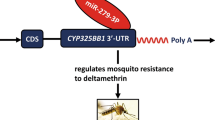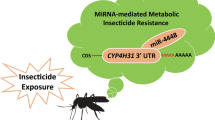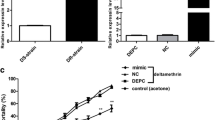Abstract
MicroRNAs (miRNAs) regulate gene expression and biological processes including embryonic development, innate immunity, and infection in many species. Emerging evidence indicates that miRNAs are involved in drug resistance. However, little is known about the relationship between the miRNAs and insecticide resistance in mosquitos. Here, we reported that conserved miR-278-3p and its target gene are critical for pyrethroid resistance in Culex pipiens pallens. We found that CYP6AG11 is the target of miR-278-3p, through bioinformatic analysis and experimental verification. The expression level of miR-278-3p was lower, whereas the level of CYP6AG11 was higher in deltamethrin-resistant strain, which were detected using quantitative reverse transcription PCR (qRT–PCR). We also found that CYP6AG11 was regulated by miR-278-3p via a specific target site with the 3′ untranslated region (UTR) by luciferase reporter assay. In addition, overexpression of CYP6AG11 in the mosquito C6/36 cells showed better proliferation than the cells with empty vector when treated by deltamethrin at different concentrations. Moreover, the overexpression of miR-278-3p through microinjection led to a significant reduction in the survival rate, and the level of CYP6AG11 was simultaneously reduced. These results indicated that miR-278-3p could regulate the pyrethroid resistance through CYP6AG11.








Similar content being viewed by others
References
Aizoun N et al (2013) Comparison of the standard WHO susceptibility tests and the CDC bottle bioassay for the determination of insecticide susceptibility in malaria vectors and their correlation with biochemical and molecular biology assays in Benin, West Africa. Parasite Vectors 6:147
Azizullah A et al (2014) Chlorophyll derivatives can be an efficient weapon in the fight against dengue. Parasitol Res. doi:10.1007/s00436-014-4175-3
Bonizzoni M et al (2012) Comparative transcriptome analyses of deltamethrin-resistant and -susceptible Anopheles gambiae mosquitoes from Kenya by RNA-Seq. PLoS One 7(9):e44607
Bouvier JC, Boivin T, Beslay D, Sauphanor B (2002) Age-dependent response to insecticides and enzymatic variation in susceptible and resistant codling moth larvae. Arch Insect Biochem Physiol 51(2):55–66
Bouzid M, Colon-Gonzalez FJ, Lung T, Lake IR, Hunter PR (2014) Climate change and the emergence of vector-borne diseases in Europe: case study of dengue fever. BMC Public Health 14(1):781
Cai ZG, Zhang SM, Zhang H, Zhou YY, Wu HB, Xu XP (2013) Aberrant expression of microRNAs involved in epithelial-mesenchymal transition of HT-29 cell line. Cell Biol Int 37(7):669–674
Chandor-Proust A et al (2013) The central role of mosquito cytochrome P450 CYP6Zs in insecticide detoxification revealed by functional expression and structural modelling. Biochem J 455(1):75–85
Chang Y et al (2010) Hepatic stellate cell-specific gene silencing induced by an artificial microRNA for antifibrosis in vitro. Dig Dis Sci 55(3):642–653
Chen J, Liang Z, Liang Y, Pang R, Zhang W (2013) Conserved microRNAs miR-8-5p and miR-2a-3p modulate chitin biosynthesis in response to 20-hydroxyecdysone signaling in the brown planthopper, Nilaparvata lugens. Insect Biochem Mol Biol 43(9):839–848
Dedeoglu BG (2014) High-throughput approaches for microRNA expression analysis. Methods Mol Biol 1107:91–103
Edi CV et al (2014) CYP6 P450 enzymes and ACE-1 duplication produce extreme and multiple insecticide resistance in the malaria mosquito Anopheles gambiae. PLoS Genet 10(3):e1004236
Fulci V et al (2007) Quantitative technologies establish a novel microRNA profile of chronic lymphocytic leukemia. Blood 109(11):4944–4951
Govindarajan M, Sivakumar R (2014) Larvicidal, ovicidal, and adulticidal efficacy of Erythrina indica (Lam.) (Family: Fabaceae) against Anopheles stephensi, Aedes aegypti, and Culex quinquefasciatus (Diptera: Culicidae). Parasitol Res 113(2):777–791
Hewezi T, Maier TR, Nettleton D, Baum TJ (2012) The Arabidopsis microRNA396-GRF1/GRF3 regulatory module acts as a developmental regulator in the reprogramming of root cells during cyst nematode infection. Plant Physiol 159(1):321–335
Huang XM et al (2012) Cloning and identification of microRNAs in earthworm (Eisenia fetida). Biochem Genet 50(1–2):1–11
Huber K et al (2014) Distribution and genetic structure of Aedes japonicus japonicus populations (Diptera: Culicidae) in Germany. Parasitol Res 113(9):3201–3210
Kotewong R, Duangkaew P, Srisook E, Sarapusit S, Rongnoparut P (2014) Structure-function relationships of inhibition of mosquito cytochrome P450 enzymes by flavonoids of Andrographis paniculata. Parasitol Res 113(9):3381–3392
Lee RC, Feinbaum RL, Ambros V (1993) The C. elegans heterochronic gene lin-4 encodes small RNAs with antisense complementarity to lin-14. Cell 75(5):843–854
Lee KH et al (2014) MicroRNA-296-5p (miR-296-5p) functions as a tumor suppressor in prostate cancer by directly targeting Pin1. Biochim Biophys Acta 1843(9):2055–2066
Lertkiatmongkol P, Jenwitheesuk E, Rongnoparut P (2011) Homology modeling of mosquito cytochrome P450 enzymes involved in pyrethroid metabolism: insights into differences in substrate selectivity. BMC Res Notes 4:321
Li L et al (2012) Differences in microRNAs and their expressions between foraging and dancing honey bees, Apis mellifera L. J Insect Physiol 58(11):1438–1443
Liu Q, Tuo W, Gao H, Zhu XQ (2010) MicroRNAs of parasites: current status and future perspectives. Parasitol Res 107(3):501–507
Marimuthu G, Rajamohan S, Mohan R, Krishnamoorthy Y (2012) Larvicidal and ovicidal properties of leaf and seed extracts of Delonix elata (L.) Gamble (family: Fabaceae) against malaria (Anopheles stephensi Liston) and dengue (Aedes aegypti Linn.) (Diptera: Culicidae) vector mosquitoes. Parasitol Res 111(1):65–77
Pio G, Malerba D, D’Elia D, Ceci M (2014) Integrating microRNA target predictions for the discovery of gene regulatory networks: a semi-supervised ensemble learning approach. BMC Bioinforma 15(Suppl 1):S4
Qiu L, Wang H, Xia X, Zhou H, Xu Z (2008) A construct with fluorescent indicators for conditional expression of miRNA. BMC Biotechnol 8:77
Samaraweera L, Grandinetti KB, Huang R, Spengler BA, Ross RA (2014) MicroRNAs define distinct human neuroblastoma cell phenotypes and regulate their differentiation and tumorigenicity. BMC Cancer 14:309
Somwang P et al (2011) Enzymes-based resistant mechanism in pyrethroid resistant and susceptible Aedes aegypti strains from northern Thailand. Parasitol Res 109(3):531–537
Teleman AA, Maitra S, Cohen SM (2006) Drosophila lacking microRNA miR-278 are defective in energy homeostasis. Genes Dev 20(4):417–422
Truini A et al (2014) Role of microRNAs in malignant mesothelioma. Cell Mol Life Sci 71(15):2865–2878
White MT et al (2014) Negative cross resistance mediated by co-treated bed nets: a potential means of restoring pyrethroid-susceptibility to malaria vectors. PLoS One 9(5):e95640
WHO (2013) Test procedures for insecticide resistance monitoring in malaria vector mosquitoes. WHO, Geneva
Yang Z et al (2014) Serum miR-23a, a potential biomarker for diagnosis of pre-diabetes and type 2 diabetes. Acta Diabetol. doi:10.1007/s00592-014-0617-8
Yu H et al (2012) Epstein-Barr virus downregulates microRNA 203 through the oncoprotein latent membrane protein 1: a contribution to increased tumor incidence in epithelial cells. J Virol 86(6):3088–3099
Zellweger RM, Miller R, Eddy WE, White LJ, Johnston RE, Shresta S (2013) Role of humoral versus cellular responses induced by a protective dengue vaccine candidate. PLoS Pathog 9(10):e1003723
Acknowledgments
This work was supported by the National Institutes of Health of US (NIH) (Grant No. R01AI075746), the National Natural Science Foundation of China (Grant Nos. 81171900, 81101279, and 81301458), the National S&T Major Program (Grant Nos. 2012ZX10004-219 and 2012ZX10004-220), Specialized Research Fund for the Doctoral Program of Higher Education of China (Grant No. 20113234120007), and Natural Science Foundation of Jiangsu Province (Grant No. 81101279).
Author information
Authors and Affiliations
Corresponding author
Rights and permissions
About this article
Cite this article
Lei, Z., Lv, Y., Wang, W. et al. MiR-278-3p regulates pyrethroid resistance in Culex pipiens pallens . Parasitol Res 114, 699–706 (2015). https://doi.org/10.1007/s00436-014-4236-7
Received:
Accepted:
Published:
Issue Date:
DOI: https://doi.org/10.1007/s00436-014-4236-7




